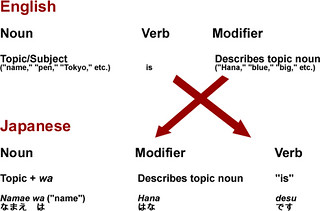Its good to be back, and in this time I would like to share some of my thought about differences between Japanese grammar and English grammar when I
learn Japanese. Of course this is my personal opinion so it is open for debate. Have fun!
1 - Difference in Characters:

The most obvious difference between English grammar and Japanese grammar is probably the characters. In English, or Italian, or Frence, .etc.., all of these languages follow Latin characters from A to Z. However, Japanese grammar does not have Latin characters, it has its own 3 types of characters: Hiragana, Katakana, and
Kanji symbols. Sounds terrifying isn't it? While Latin script has 26 characters, Hiragana and Katakana script each has 46 and 45 characters. "Okay, so you tell me that if I'm going to learn Japanese, I'll have to learn 2 characters script with 91 characters in total?". Um... yes, you have to learn all of them. But wait! If you think that is over? Guess what, you will have to learn thousands of Kanji characters (based on Chinese characters) in which each character/word holds a difference meaning. So yes, in terms of characters. Japanese is hard.
2 - Difference in Verb Tense:

You have just read about Japanese characters and you are still afraid of learning Japanese? Then here is a good news for you. Unlike English grammar which has tons of verb tenses, ranging from past tense to the future tense and each tense has 4 forms: simple, progressive, perfect, and perfect progressive; Japanese grammar only has 2 verb tenses: past and present tense and each tense has formal and informal form. That's it! 2 tenses, in details, verbs in Japanese has "masu" ending. In present tense, the positive form will be "masu", negative form will be "masen"; and in past tense, the positive form changes to "mashita" and negative form changes to "masendeshita". On the other hand, the formal and informal aspect are quite easy to get. Therefore there is nothing to worry about in term of Japanese grammar's verb tense.
3 - Difference in Particles order:

So normally in English grammar we follow this order: Subject - Verb - Object, for example: "I eat rice." But in Japanese grammar, the order is little bit different which is: Subject - Object - Verb. Sounds weird isn't it? If we follow this order in English, the example above will be: "I rice eat." Sounds nonsensical and funny, but actually that is how it works in Japanese. In Japanese, the sentence "I eat rice" will become "わたしはごはんを食べます" (watashi wa gohan wo tabemasu - I rice eat). This difference is not that complicated as you gradually learn Japanese. However, it means that during your Japanese learning process, especially if you are beginners and if you are learning speaking Japanese, you cannot just translate whatever sentence you see into English since the two particles orders are different. Not to mention that there is high chance that you will be confused between the two language structure, and that will not be good.
Overall personally I find it hard to compare these 2 languages since people from different countries may not think the same. But yeah for me Japanese is truly a hard language and it needs hard work.